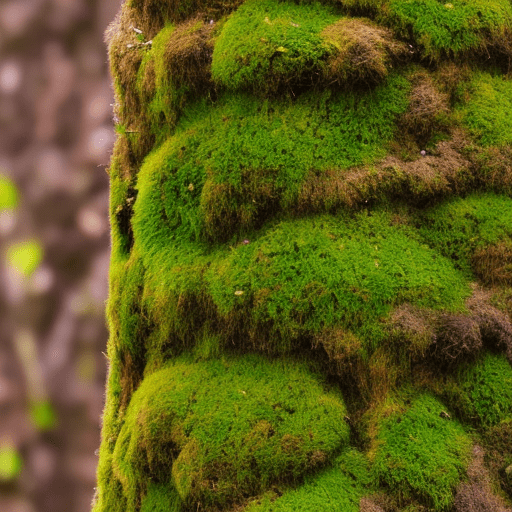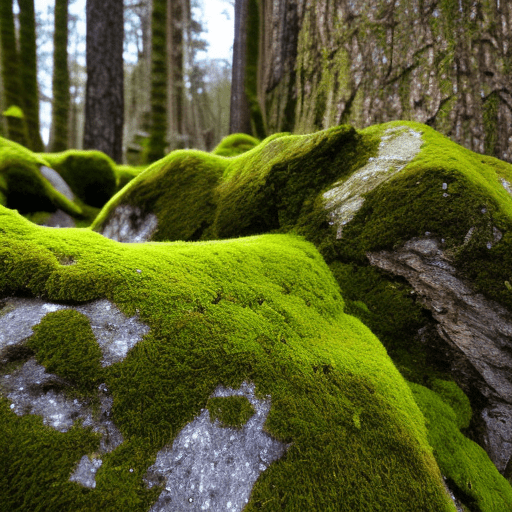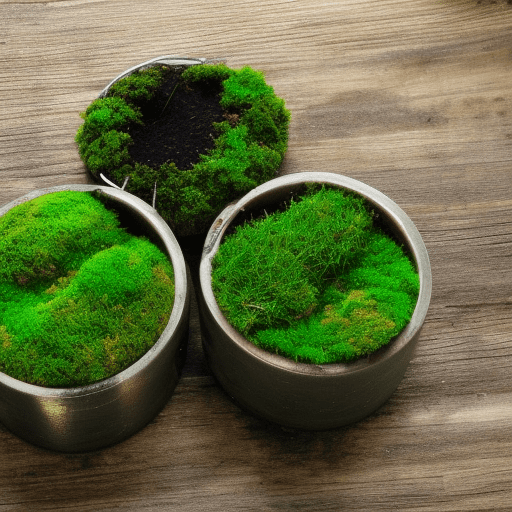Moss is a type of plant that is very common in many parts of the world.
There are many different types of moss, and each one has its unique features.
In this blog post, we will discuss the different types of moss and what makes them special.
We will also provide some tips on how to care for moss plants.
So if you’re interested in learning more about moss, keep reading!

Moss is a type of small, green plant that belongs to the division Bryophyta.
Explain it to a child
Mosses are small plants that grow on the ground in damp and shady areas.
They belong to a group of plants called bryophytes that includes about 12,000 species found all over the world.
It does not have true roots but instead anchors itself in place by tightly attaching its “root-like” structures called rhizoids to the surface it grows on.
Mosses mainly reproduce through spores and typically grow in shady, humid areas such as near water sources or in forests.
What is moss?
Moss is a non-flowering plant that thrives in humid and moist environments.

Unlike other plants, moss is non-vascular, meaning that it doesn’t need traditional stems or roots to gain nutrients from the ground.
What makes moss so special is its ability to retain moisture – whether it be living in a desert or a rainforest, moss will stay green because of its unique cell structure.
Moss forms in colonies and relies on fragments of dead vegetation, not soil, for survival; these colonies can take all sorts of shapes and sizes which give them an almost sculptural appearance.
Despite being widely underestimated by many homeowners, moss has proven itself to be one of the most resilient and adaptable organisms present on Earth today.
Moss can be categorized into two groups
Mosses are commonly classified into two main groups: Acrocarpous Mosses and Pleurocarpous Mosses.
Acrocarpous Moss grows upward in a more compact shape while Pleurocarpous Moss grows horizontally in clumps.
Depending on the type, moss has different characteristics, shapes, and growths throughout the year.
The abundance of moss species worldwide provides us with an opportunity to observe their diverse life cycles and determine how they will adapt to changing environmental conditions in the future.
Types of moss
Each of these types of moss provides an undeniably unique texture to your garden beds, from the softest evergreen blanket to sharper uprights adding texture along pathways.
Regardless of their differences, both types of moss are great groundcovers for any yard or garden space!
Moss of the American Tree
Moss of the American Tree is an incredibly diverse phenomenon, especially in terms of species within the pleurocarpous division.
Moss of the Common Haircap
Moss of the Common hair cap is a species of moss belonging to the acrocarpous classification, which exemplifies a branching habit that is upright and distinct.
Leaved Moss with a Spoon
Leaved moss with a spoon works wonders for your garden, giving a unique texture to any landscape. It is known as pleurocarpous, referring to its flat leaves that fan out from a single stem.
Turf Moss in Bloom
Acrocarpous turf moss is characterized by leaves that grow perpendicular to the surface and the green spongy clusters have a gorgeous appearance.
Moss, Heath Star
Mosses, like the Heath Star (Kamtschaticum), are known as acrocarpous species because of their upright habit with widely spaced, short stems topped by capsules in which spores are produced.
Moss of Baby Tooth
Moss of Baby Tooth is classified as pleurocarpous. It can be found all over the world, growing in forests and jungles alike, making it one of the most diverse species of flora in existence.
Moss on a Pincushion
Moss on a pincushion is an acrocarpous phenomenon, usually found in decorative fragments of nature.
Moss of Mood
Moss of mood, also known as Acrocarpous Moss, is an enchanting type of moss found growing along wet surfaces.
Seductive Shiny Moss
Seductive Shiny Moss has a unique allure that draws many onlookers to its glossy, brilliant green leaves. Its pleurocarpous form allows Seductive Shiny Moss to spread itself and take up space without overgrowing other surrounding plants.
Plum Moss
Plum Moss is a unique moss with an alluring, shimmering quality that draws the eye and seduces even the most jaded of nature lovers. Plum Moss has a pleurocarpous growth pattern.
Bog Moss with Ribs
Bog Moss with Ribs (acrocarpous) is a stunning species of moss. It features distinctive vertical wavy ribs that stand out against its delicate green color, giving it a unique visual appearance that is sure to draw the eye.
Screw Moss in Water
Screw Moss in Water is an acrocarpous way to add a unique texture to a landscape. Screw Moss has small, round leaves with a distinctly feathery texture, making it an eye-catching addition to any garden.
Gleaming Wood Moss
Gleaming Wood Moss is a type of Pleurocarpous moss that is known for its silvery sheen. It can often be found growing in moist and shady areas, such as woodlands or lowland forests.
Moss Juniper
Moss Juniper is an acrocarpous type of common Moss found in most countries around the world. This unique species grows close to the ground and features small, needle-like leaves.
Shaggy Moss
Shaggy Moss is a type of pleurocarpous moss that grows in thick carpets. Its soft, short stems and trailing branches look like a shaggy fur coat when viewed from afar. Its leaves are plump, bright green, and shaped like stars.
Tamarisk Moss (Common)
Tamarisk Moss (Common) is an acrocarpous type of moss that is commonly found growing on rocks, soil, and trees in and around arid regions.
The Catherine moss
The Catherine moss is a rare and unique natural beauty that has drawn the admiration of botanists the world over. A member of the Acrocarpous family, the plant tends to bloom towards the end of the summer, clinging tenaciously to exposed rocks and other surfaces with only shallow soil covering them.
Moss of the Dwarf Haircap
Moss of the Dwarf Haircap is a type of acrocarpous moss, which means it produces its spore capsules on the tips of long stalks. Moss of the Dwarf Haircap grows best in shady areas and cool to moist regions such as Scotland and Ireland.
Moss of Rigid Beard
Moss of Rigid Beard, or Acrocarpous as it is otherwise known, is a type of moss that has rigid, usually straight beards. It often grows in grassy regions and has been found to grow at elevations up to eight thousand feet.
What is the best type of moss?
Moss is an amazing type of plant due to its small size, versatility, and hardiness.
However, when it comes to deciding on the best type of moss, there is no definitive answer as different types can be used for different purposes.
Where does moss grow?
Moss is a fascinating plant that can be found around the world and in various climates. Where do you find it most?

Moss naturally thrives in damp environments, whether by a river or lake, under or near a tree or large bush, or in shaded spots with limited sun.
Moss often grows on stones, soil, logs, and trees in moist forests that don’t receive much direct sunlight.
In addition to these natural spots, one of the places people are most likely to come across it is on the north sides of houses as moss prefers shadier areas that remain cooler than south-facing ones.
Can you grow moss?

Yes! Moss makes for an ideal addition to any outdoor space; it’s low maintenance and a beautiful green color at the same time.
Moss is an excellent ground cover, as it can retain water across expansive areas without requiring much care.
With the right planting conditions – some shade, adequate moisture, and flat terrain – anyone can create a lush and vibrant moss garden in no time.
Additionally, cuttings from one location can be taken and replanted into new sites with no problems.
Which moss is easiest to grow?
With so many different types of moss, it’s hard to choose which variety is best when it comes to cultivating your moss garden.
Fortunately, the answer is relatively straightforward sheet moss is the most widely recommended choice for indoor and outdoor spaces alike, due to its ease of growth and ability to quickly adapt to its environment.
For example, sheet moss prefers indirect sunlight and a humid climate which makes it an ideal candidate in shady woodland gardens or even within a terrarium.
How long can moss live?
Moss life cycles usually range from 10-50 years and many of them don’t depend on an external source for nutrients and water, which makes them capable of surviving even in harsher climates or habitats.
Additionally, the cells that form most moss have a unique ability to resist desiccation while at the same time allowing them to revive quickly with moisture when it becomes available.
Finally, because they thrive in humid areas, they can easily spread between clumps and even cover large surfaces when conditions are right.
Mosses are a type of small, non-vascular plant living on the ground in damp and shady areas.
They belong to a group of bryophytes that includes about 12,000 species distributed around the world.
Mosses have been an important part of ecosystems for millions of years and have adapted to diverse climates from cold deserts to tropical rainforests
Article Sources
Jacks of Science sources the most authoritative, trustworthy, and highly recognized institutions for our article research. Learn more about our Editorial Teams process and diligence in verifying the accuracy of every article we publish.
